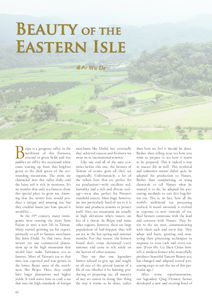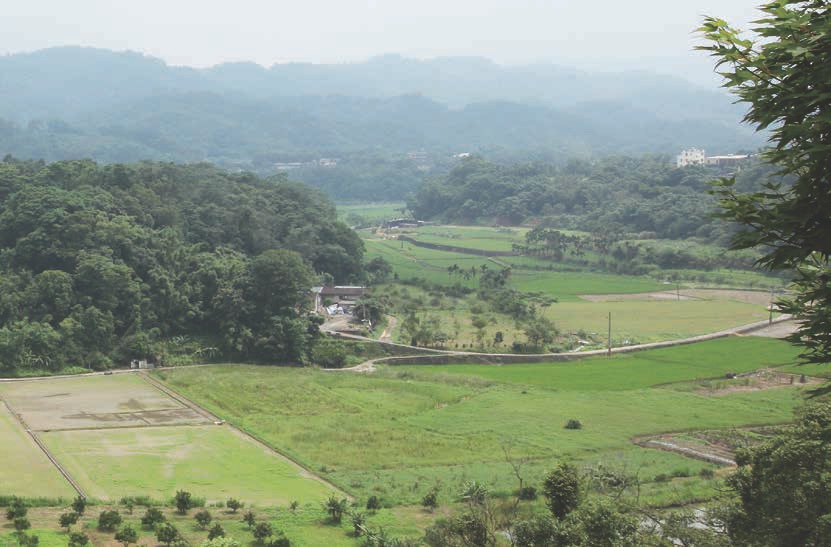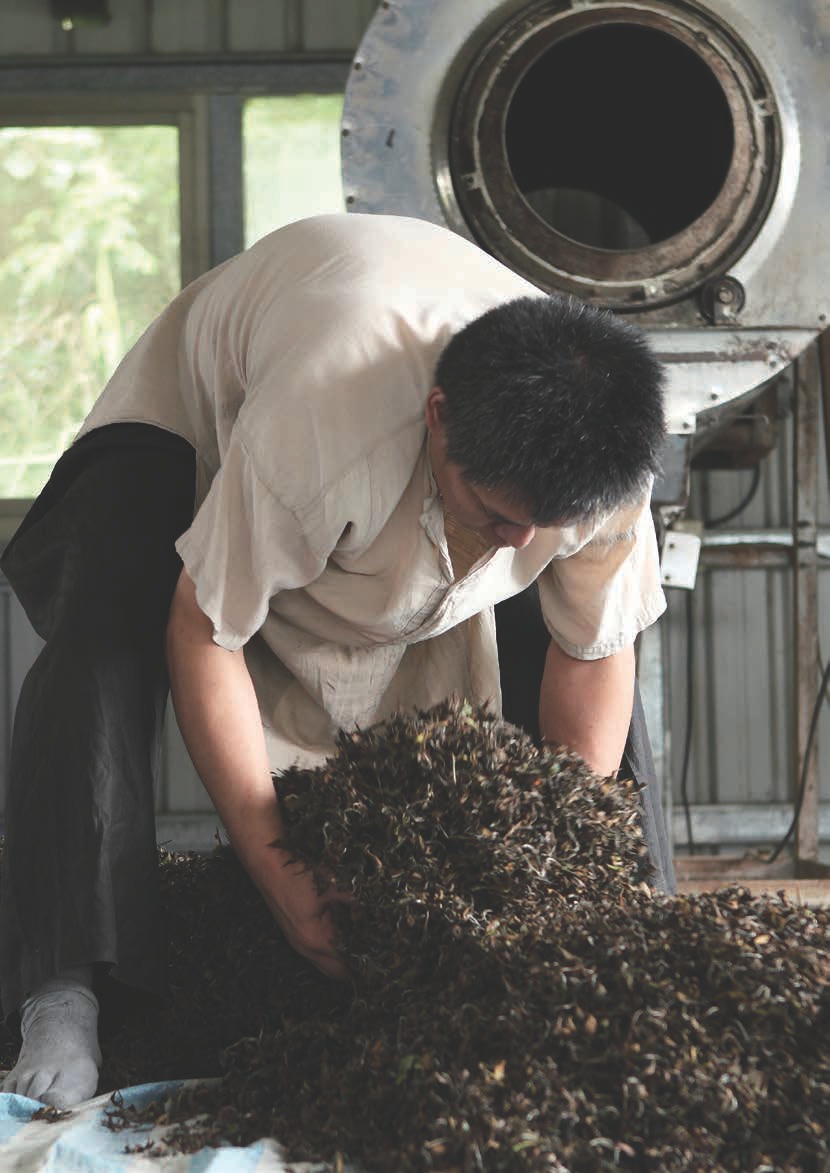
 |
|
Beipu is a gorgeous valley in the northwest of this Formosa, covered in green fields and rice paddies set off by the occasional white crane soaring up from that brighter green to the dark green of the surrounding mountains. The mists are channeled into this valley daily, and the loose soil is rich in nutrients. It's no wonder that early tea farmers chose this special place to grow tea, knowing that the terroir here would produce a unique and amazing tea, but they couldn't know just how special it would be...

In the 19th century, many immigrants were crossing the strait from Fujian to start a new life in Taiwan. Many started growing tea for export, primarily to sell to famous merchants like John Dodd. At that time, there weren't yet any commercial plantations up in the high mountains that would later make Taiwanese tea so famous. Most of Taiwan's tea at that time was exported and was grown in the lower, flatter areas of the northwest, like Beipu. Here, they could have larger plantations and higher yields. It took some time to craft a tea that met the high standards of foreign merchants like Dodd, but eventually they achieved success and Formosa tea went on to international renown.
Like any and all of the sane centuries before this one, the farmers of Taiwan of course grew all their tea organically. Unfortunately, a lot of the valleys here that are perfect for tea production - with excellent soil, humidity and a rich and diverse ecology - were also perfect for Nature's manifold insects. Most bugs, however, are not particulary fond of tea as it is bitter and produces tannins to protect itself. Also, tea mountains are usually at high elevations where insects are less of a threat. In Beipu and some other regions, however, there are large populations of leaf-hoppers that will eat tea in the late spring and summer months. For that reason, the farmers found their crops decimated every summer, and came to rely solely on the harvest of other seasons.

They say that one legendary farmer refused to give up, and taught us all one of the pivotal lessons of a life of tea, whether it be farming, producing or preparing tea: all mastery of any art comes in doing that thing the way it wants to be done, rather than how we feel it should be done. Rather than telling your tea how you want to prepare it, see how it wants to be prepared. This is indeed a way to master life as well. This mythical and unknown master didn't quit; he adapted his production to Nature. Rather than complaining, or using chemicals to tell Nature what he wanted it to do, he adapted his processing methods to suit this bug-bitten tea. This is, in fact, how all the world's traditional tea processing evolved. It wasn't invented; it evolved in response to new varietals of tea. Real farmers commune with the land and converse with Nature. They listen to the tea trees, communicating with them each and every day. They adapt and learn, growing and mastering their processing techniques in response to trees each and every season. (Even Mr. Gu Shen Chien himself, a modern farmer who masterfully produces beautiful Eastern Beauty tea, has changed and adapted several processing steps to suit the tea of this particular age.)
After some experimentation, our legendary Qing Dynasty farmer developed a new and exciting kind of oolong that was processed in a way that enhanced the bug-bitten summer leaves. While other farmers were throwing away their crops, he sold it all to John Dodd. As legend has it, this amazing tea was so good that it reached the august hands of Queen Elizabeth II, who was herself a great tea lover. She reportedly favored the tea above all others and named it "Eastern Beauty."
In the 1970s, Taiwan's booming economy shifted from agriculture to industry and technology. As the quality of life rose dramatically, people moved from rural places like Beipu to cities like nearby Hsinchu. More and more people became interested in culture as they grew more affluent. High-mountain oolong from central Taiwan grew in popularity throughout the island and beyond, so much so that most people think of such tea first when they think of Taiwanese tea. The dwindling of land for tea plantations, migration to the city and the aging of the tea farmers themselves threatened the very existence of Taiwan's Eastern Beauty. There were some families who carried on, nonetheless.
Mr. Gu is a fourth-generation Eastern Beauty farmer who has, like his father before him, worked incredibly hard to preserve this amazing tea culture. They worked hard and expanded their traditional holdings to a neighboring field. With increased savings and years of hard work, they were able to revitalize Beipu's Eastern Beauty production. In 2000, Mr. Gu's Bao Ji Tea Company bought back several abandoned Eastern Beauty farms, cleared several hectares and planted saplings there. They have thrived and are beginning to produce tea again.
Mr. Gu's son has this year begun to take an active role in the family's production, ensuring a future for Eastern Beauty and a fifth generation of magical Bao Ji tea. It is returning to popularity and more people are discovering or returning to this amazing tea.
Mr. Gu's organic Eastern Beauty is a real treat, as is any time in his company. He does a lot to promote sustainable agriculture that protects Nature and traditional culture. He is simple, genuine and giving, and he enthusiastically leapt at the opportunity to donate some of his tea to our Center. His face lit up when we told him people around the world would have a chance to appreciate his tea as much as we do. We hope that any of you who visit Taiwan get a chance to visit with him and share a traditional Hakka meal and some amazing tea. His tea center also does a lot to promote and preserve other aspects of Hakka culture like food, ground tea (leicha), pomelo tea, vinegar production, regional art and music and even bamboo tea utensils carved by hand. His son is actually also quite famous for making amazing tea utensils.
The magic of Eastern Beauty starts with the leaf-hoppers who bite the leaves in the early summer. They usually eat the first flush and then the plant responds by producing a second flush with more tannins to discourage the insects. When these little green friends return, they often only bite part of the leaves before moving on to less bitter plants. There are enzymes in their saliva which cause the leaves to begin to oxidize before they are even picked, turning red around the edges and growing at a crooked angle from the stem. These unique leaves are the ones used for Eastern Beauty.
Eastern Beauty oolong production involves many unique steps not found in other teas, one of which is that the tea is actually sorted as it is picked, which requires a slower and more involved picking process. The highest grades are all bug-bitten leaves, and exclusively one bud with two leaves, as it is with most high-grade teas. This requires a much more careful and arduous tea-picking. The pickers must carefully select only the best bud-leaf sets and pick them one by one. This is, of course, only for the highest grades of Eastern Beauty tea. At Bao Ji Tea, Mr. Gu and his team produce five levels of tea. The lower grades can actually be picked at a normal speed relative to other hand-picked tea in the world.
Don't assume that just because these katydids are an essential part of Eastern Beauty production that all such tea is organic. Actually, very few Eastern Beauty farmers are organic nowadays. They have perfected the art of spraying their trees at the right times to prevent and allow bugs, and many still use chemical fertilizers and weed-killers as well. Mr. Gu's method is special and his organic tea is rare and clean. He has recorded more than twenty species of insects that interact with and affect his tea, not just the jassids that bite the leaves. Real tea production involves an entire ecology.

Eastern Beauty is the most oxidized of all oolong teas, in part because it begins oxidizing on the tree before it is picked, and in part because of the arduous withering process that begins as soon as the tea reaches the tea processing plant from the field. Mr. Gu, his son and a helper sleep but a few hours during the three weeks of annual Eastern Beauty production, as is the case with most traditional oolong producers who still follow Nature and harvest but once a year, as their entire year's income is dependent upon this tea.
The tea is spread out on sheets to wither for a long time. Eastern Beauty tea will be oxidized to around 80% by the time it is done. The initial withering (shai qing, 曬青) is done for about fourteen hours on a covered, sunlit roof and sometimes indoors, depending on the weather and the grade of the tea (higher grades are done indoors and monitored much more carefully). On the roof, they have black cloth with holes that can automatically cover the entire area - rolling out like a garage door on electric shafts when needed. They shade the tea during the noon hours, and then retract the slightly transparent black cloth when it isn't as bright. All of this requires careful observation and great skill. After the tea is adequately withered, it is laid in a long pile to be shaken. The higher grades of tea are shaken entirely by hand, while the lower grades are tumbled in a machine for twenty minutes and then shaken by hand. As Mr. Gu says, "the machines cannot be trusted with our precious tea." This shaking stirs the tea up and exposes every leaf to more oxygen. You can grab a handful of the tea Mr. Gu has shaken and another from the part of the pile that is yet to be shaken and smell the difference between them quite distinctly: the previously shaken tea is much more full-bodied, richer and more fragrant. The tea is then spread out once again to be withered even more. It will eventually go through four cycles of withering and shaking, though only the first is so long.


At the end of the withering and stirring/shaking, the tea is piled (jing tze, 靜置 / wo dui, 臥堆) to further oxidize it. It is piled on a round bamboo mat and covered with a cloth. Nearly all Eastern Beauty farmers use wet piling and withering throughout their tea production, as this is quicker and more convenient. Mr. Gu says it could increase their production by as much as 30%, but he doesn't believe that quantity is as important as quality and therefore uses a completely dry process, even drier than what was ever done traditionally. He says these adaptations are his own, and they are what separates his tea from other Eastern Beauties. When the tea is piled, it is usually around 60% oxidized. It will then complete the other 20% in four to eight hours of piling, depending on the weather and the grade of the tea.
After the tea is fully oxidized, it is fired (sha qing, 殺青). This stage, literally called "kill-green," destroys enzymes that make tea bitter and arrests further oxidation. It is done in a gas-heated tumbler that is heated to around 280 degrees. After just a few minutes inside, the tea is then rolled into a ball inside a wet cloth. The cloth is damp only because Mr. Gu's special tea has up until this point been withered, shaken, piled and fired in a dry way - very unique for Eastern Beauty production. This stage of Eastern Beauty production is also very unique. The tea will rest in tight balls, which are bagged and placed in crates for around twenty minutes before being rolled (rou nian, 揉捻). The rolling breaks down the cell walls of the tea and releases the juices. Mr. Gu reminded us once again that he doesn't trust the machines with his heritage, and therefore rolls his tea three times, twice by machine and once by hand. When the tea emerges from its rolling, it is at its most fragrant, and a handful is enough to send you to the fabled Heavens Chinese people once believed existed across the strait and up Taiwan's cloud-enshrouded mountains.
After the rolling, the tea is once again piled (wo dui) for twenty or thirty minutes. At this time it is roasted gently at low temperatures for around three hours. This first roast is called a "water roast (shui pei, 水焙)." It's done in a large oven with trays that are inserted horizontally, like shelves. It is not a real roast, but just to dry the tea and put it in stasis - a limbo that will last until the end of the growing season. Roasting oolong tea is the most difficult and potentially dangerous aspect of tea processing. Roasting secrets are guarded both in Taiwan and China, and often only known to the father and son. As the roast takes days and requires constant monitoring, there is no time to roast all the tea during the growing season. The need to have the tea processed by day's end consumes all the farmers' time. Consequently, tea is always roasted briefly to arrest oxidation and dry the leaves sufficiently for it to sit in bags for the remaining weeks of the growing season. Then, after the season's tea has all been processed, the farmers can catch up on some muchneeded sleep and get started roasting the tea properly. That way, the roasting is done carefully and slowly, as it is an important step.
Before the final roasting the tea must be sorted (fan ji). The tea is first sieved through bamboo to remove all the fannings, which are later used in tea bags. The larger leaves are then spread out on large tables where they are sorted by size and quality by hand. This is necessary at this stage because different grades of tea are roasted in different ways. Usually, lower grade oolong teas have always been given a heavier roast to cover up the defects in the tea. In places like Wuyi - and here in Beipu as well - lower grade tea is also often a blend of different kinds of leaves and cultivars, so the roast helps bring a kind of uniformity to these teas. The highest grades will be composed exclusively of buds.
The final roasting is divided into three stages. It is done in large, round bamboo roasters with electric elements underneath that are meant to mimic the heat of charcoal, which was used traditionally. Mr. Gu would love to use charcoal to roast his tea, but recently the prices of hardwood charcoal have risen dramatically. Taiwan has a very unique kind of smokeless charcoal made from dragon eye trees. We actually use it here at the Center to heat all our water. It is renowned worldwide for the amazing influence it can have on roasting oolong tea, but the tree grows slowly and over-harvesting has driven the prices beyond what most farmers can afford. Mr. Gu therefore roasts his highest grade with charcoal and uses electric roasters for the four lower grades.
The first roast is only two to four hours long, and is called the "zhou jing pei (做驚焙)." It awakens the tea from its slumber. Then there is a second roast called the "pei ze di (焙 之蒂)," which begins to enhance the tea and bring out its unique flavors. It is "roasting the body" of the tea. The final roast is where the real favor is enshrined into this amazing tea, is called the "pei xiang wei (焙香味)," which means that it locks in the fragrance. This is the point at which Mr. Gu uses charcoal for his highest grade teas.
The tea is then sorted once more and packaged for sale. It should rest for some time, usually at least a few months, to let the roast settle down and leave the tea. Otherwise, this will be the only recognizable flavor. They say that a good roast enhances the tea without leaving any trace of itself.
As you can see, a tremendous amount of effort goes into the production of this amazing tea: billions of years of evolution, a glorious dance of Nature between the tiny jassids and enzymes in their saliva, hours of sweating in the summer sun to clear abandoned farms and replant this tea, shirtless and sleepless weeks on the roof of the tea processing center withering, shaking, piling, firing, rolling and roasting, and of course doing it all with great skill and a bit of gratitude, which Mr. Gu definitely manages. This wonderful collaboration between Nature, from Heaven to Earth - and from the tiniest insects to Man - is an inspiration that concludes in your soul, from sip to sip...


- Four cycles of withering shaking -